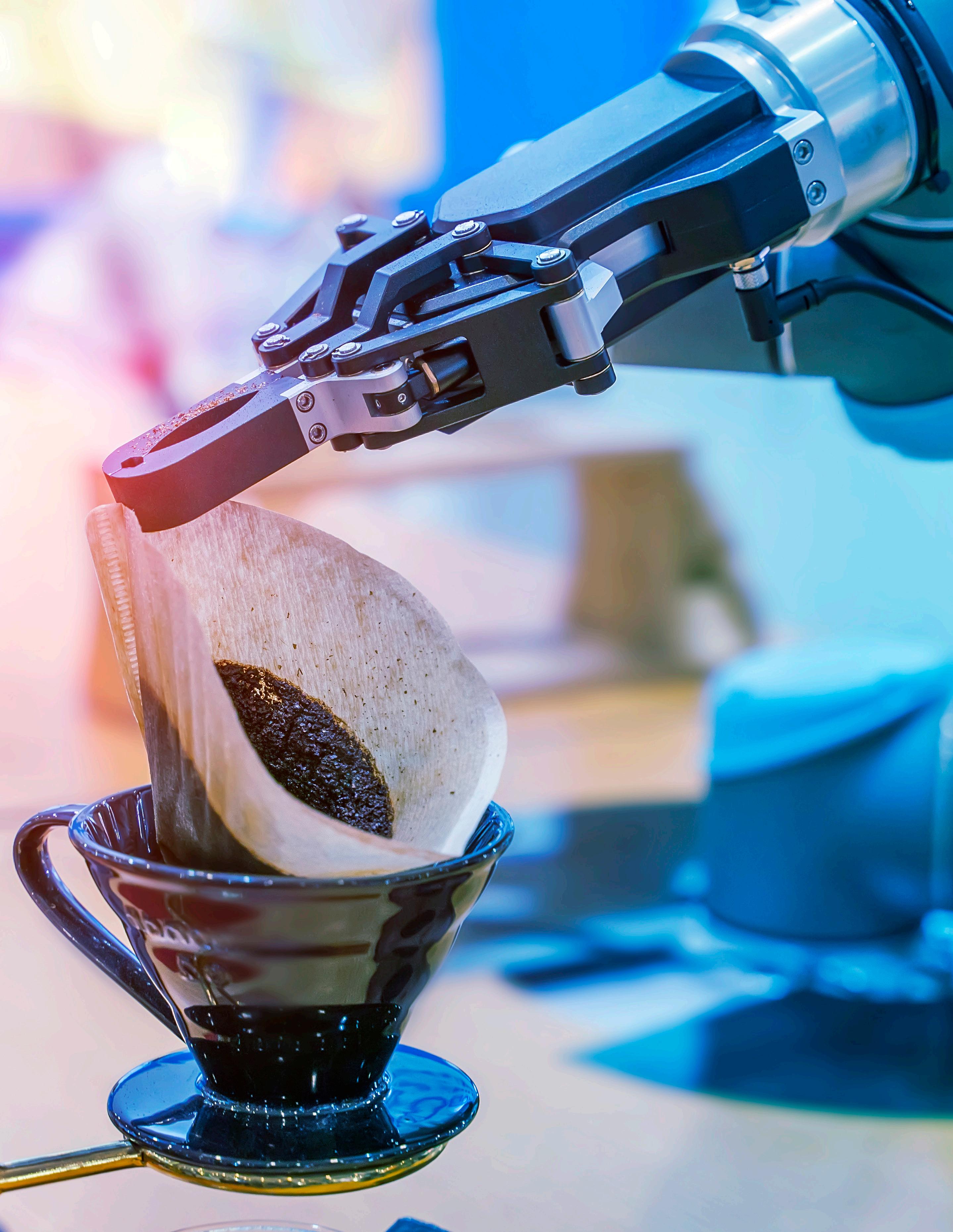
Surge ��� TECHNOLOGY ISSUE 2022 | Vol. XXXV No.7 THIS MONTH: TECHNOLOGY & SUSTAINABILITY

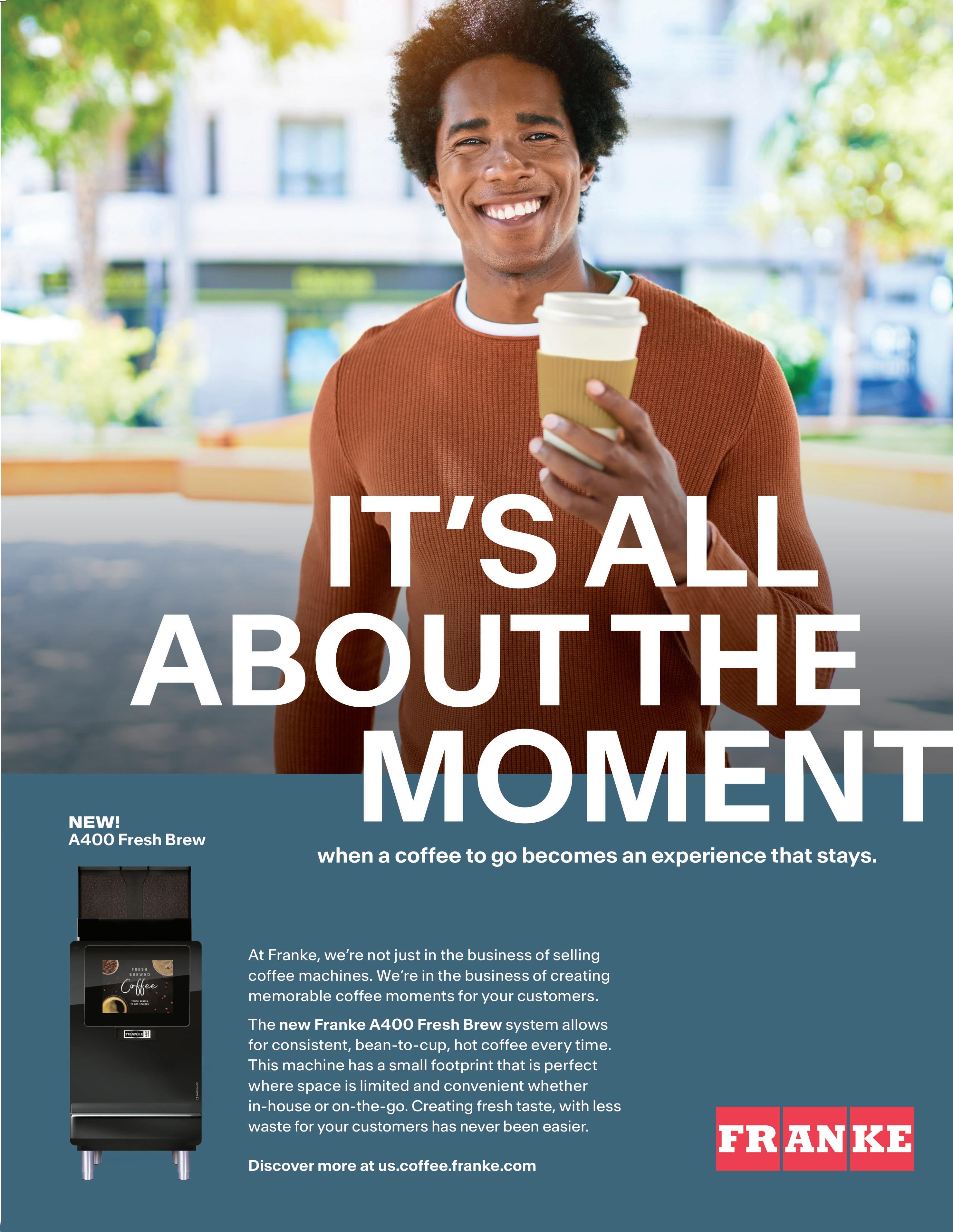


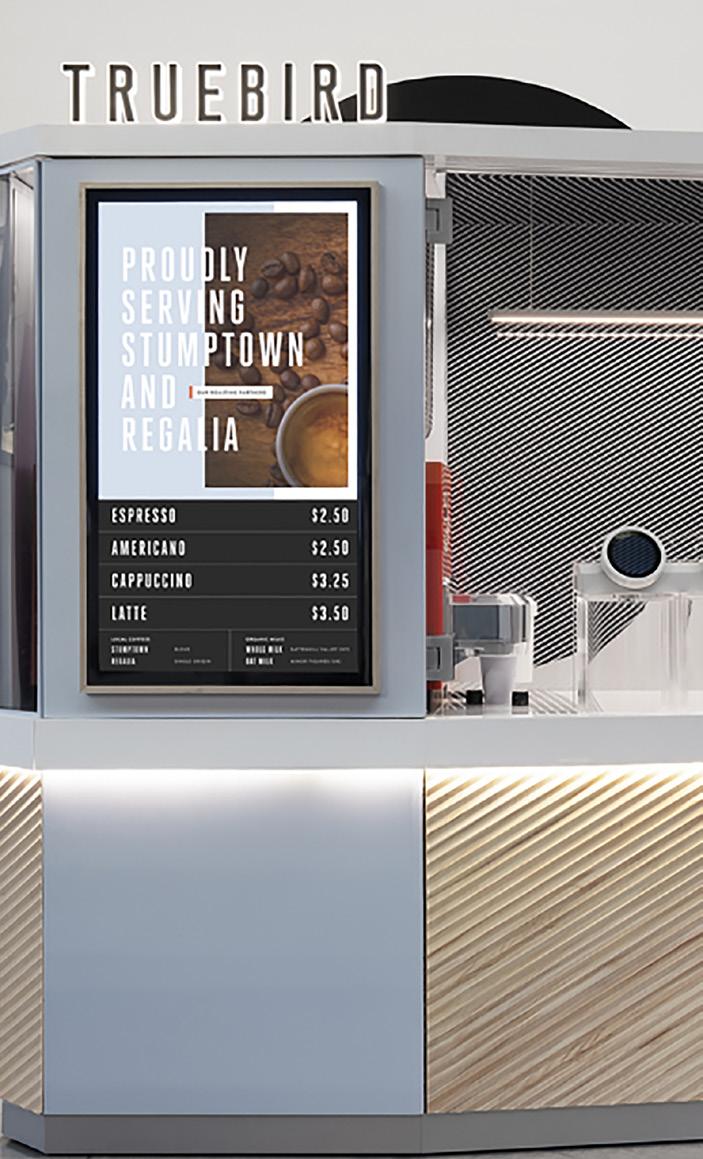
2022 | TECHNOLOGY ISSUE COFFEETALK MAGAZINE{ 4 } CONTENTS TECHNOLOGY ISSUE 2022 #7 THE VIEW Into the Future JAKE LEONTI 06 ENSURING SUSTAINABILITY A People-Centered Partnership BILL FISHBEIN 12 BARRISTA3PO How Big Tech is Surging in Coffee Shops JAKE LEONTI 08
PUBLISHER
EDITOR-IN-CHIEF
LEONTI
ADMINISTRATION
GOODMAN
CREATIVE DIRECTOR
JUSTIN GOODMAN
PRINT DESIGNER
MARCUS FELLBAUM
MAILING INFO
LLC
77th Ave SW
WA
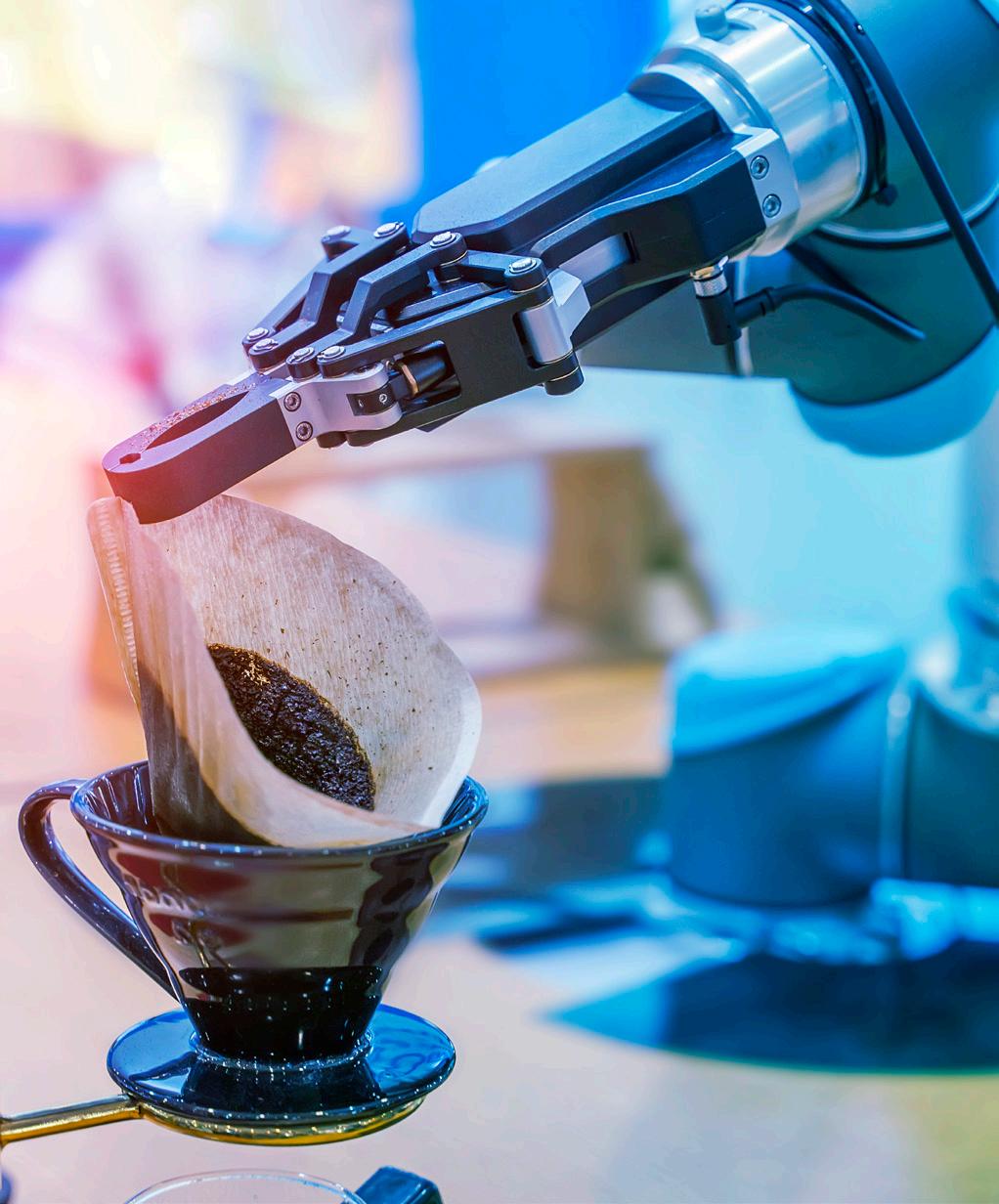
DISCLAIMER
does not assume the respon sibility for validity of claims made for advertised products and services. We reserve the right to reject any advertis ing. Although we support copyrights and trademarks, we generally do not include copyright and trademark symbols in our news stories and columns. CoffeeTalk considers its sources reliable and verifies as much data as possible. However, reporting inaccuracies can occur, conse quently readers using this information do so at their own risk.
CONTACT
P: 206.686.7378
866.373.0392 www.coffeetalk.com
POSTMASTER
Send address changes to HNCT, LLC, 25525 77th Ave SW, Vashon, WA 98070
SUBSCRIPTIONS
The cost of a subscription in the U.S. is $47.50 per year; in Canada, the cost is $72.00. Free to qualified industry profes sionals. Non-qualified requests may be rejected. Publisher reserves the right to limit the number of free subscriptions. For subscription inquiries, please call 206.686.7378 x1 or subscribe online at www.CoffeeTalk.com.

NEED TO UPDATE YOUR SUBSCRIPTION OR ADDRESS? COFFEETALK.COM/SUBSCRIBE
KERRI GOODMAN kerri@coffeetalk.com { 206.686.7378 x1 } COPYRIGHT © 2022, HNCT, LLC, ALL RIGHTS RESERVED
HNCT,
25525
Vashon,
98070
CoffeeTalk
F:
Advertisers { INDEX } Add A Scoop / Juice Bar Solutions Inc (415) 382-6535 | ADDASCOOP.COM 11 Costellini's (877) 889-1866 | COSTELLINIS.COM 11 Franke Coffee Systems North America SEE WEB | US.COFFEE.FRANKE.COM 3 Fres-co System USA Inc. (215) 721-4600 | FRESCO.COM 9 Grounds for Health (802) 876-7835 | GROUNDSFORHEALTH.ORG 2 Java Jacket (800) 208-4128 | JAVAJACKET.COM 11 Mahlkönig SEE WEB | MAHLKOENIG.US 15 Texpak Inc | Scolari Engineering (856) 988-5533 | SCOLARIENG.NET 16 7–9 NEW YORK, NY OCT New York Coffee Festival 12–14 TOKYO, JAPAN OCT SCAJ World Specialty Conference and Exhibition 14–15 LAS VEGAS, NV NOV NAMA Coffee, Tea & Water 23–26 SEOUL, KOREA NOV World Coffee Leaders Forum 27–29 TRIESTE, ITALY OCT Triestespresso 9–12 PLAYA HERRADURA, COSTA RICA Sintercafe NOV WANT TO SUBMIT AN EVENT TO COFFEETALK'S EVENT CALENDAR? INDUSTRY CALENDAR COFFEETALK.COM/ADDEVENT WWW.COFFEETALK.COM
JAKE
jake@coffeetalk.com { x2 }
justin@coffeetalk.com { x3 }
MEAGAN
meagan@coffeetalk.com { x4 }
fellbaum@mac.com
THE VIEW
LEONTI
I{once participated in a think tank with Nestlé developing products alongside several James Beard Award-winning chefs, restauranters, food writers, and leaders in the culinary world. Nestlé held a couple of these every year and shared with us where they looked for trends to emerge in food and beverage. They said San Francisco is nor mally seven to ten years ahead
on food and beverage trends, New York is about five years ahead, LA is about three years and Boston is about five years behind. I found this fascinating and upon a recent trip to San Francisco, I found it to be true.

San Franciso is an expensive city attached to Silicon Valley and a slew of incredible universities. This is home to the most innovative tech

companies in the country. This combination of affluence, intelligence, and pioneering spirit handed down from Manifest Destiny to the Gold Rush led to the type of environment suited for forward, independent thinking. The fact that California is also an agricultural leader attracts great chefs which has created a culture of culinary exploration and expres sion that is unmatched in the US.

2022 | TECHNOLOGY ISSUE COFFEETALK MAGAZINE{ 6 }
{ Into the Future } JAKE
CoffeeTalk Magazine -41.2710849,173.2836756
The second I walk off the airplane at SFO the difference in technology and culture hit me right in the face. First, the airport is beautiful in design with seating that includes upholstered armchairs and pad ded rack seating supported with ambient lighting in the vein of a mid-century library. Continuing with the library motif, SFO is a quiet airport, so it doesn’t feel stressful.
On my way out of SFO, I pass by at least three art exhibits and a per manent museum. Finally, I am met with my first robot of the trip, Café X the robot arm barista. The arm dances and waves and occasionally makes coffee. Making my way into the city I am passed by multiple self-driving cars that are still in test mode as evidenced by the presence of a physical yet ineffectual driver.
Just as I am about to cross the sidewalk from the car to the hotel I am cut off by a delivery-bot that looks like a dorm refrigerator zooming by on four wheels. I have stepped into the future.
The refreshing part is that along with this technology comes a culture of people that are truly integrating a green attitude into their daily lives. I was not able to find one plastic bottle of water during my trip. Instead, I could only purchase aluminum reus able bottles which were easily refilled at stations throughout the city. Plastic bags were not available and almost all food packaging was compostable.
Most refreshing of all is that no matter how advanced the tech is in San Francisco, the artisans and craftspeo ple in the kitchen and at the roastery continue to march to their own beat.
As much technology and innovation are integrated into the city and even its coffee the human touch remains very prominent. Café X was the first robot coffee I have had and yet it was clear that the people of SF still prized handmade things. The cafes were bustling, and the baristas were still grinding on demand and hand-tamp ing their way through the line. Perhaps there is a balance to be struck between automation convenience and human skill and service. We just need to build a culture that respects both.

ISSUE #7 | 2022WWW.COFFEETALK.COM { 7 }
BARISTA3PO
{ How Big Tech is Surging in Coffee Shops }
{Fritz Lang’s Metropolis depicted a future where machines and industry were filling the landscape and bringing our world into the future but at the cost of human fuel. In this dystopic portrayal of the future, they were still using humans to drive the engine of the city. Humans were the ones shoveling the coal to the feed beast of an industry. Fritz had the mechanized part right but seemed to overestimate our need for people in manual and repetitive positions. Today we are seeing the age of the machine work its way into cafes and coffee shops in the form of super-automatic espresso machines, robotic arms autono mously serving espresso drinks and robotic servers carting around trays of food to customers' tables.
Humans are growing further and further from the process of making the things we love. Sardonic future-phobes may cling to Elon Musk’s prophecy of Universal Income as a sign that our society may be headed more accurately in the direction of Pixar’s Wally. The cute computer animation tells the
story of a robot in a world of lethargic, docile, and ineffective humans that have no need for physical work. The people only fill their time with the sensory pleasures of eating and file away the hours with entertainment and sleep. This neatly places people in the position of pure consumers with no true purpose.
Watching a robotic arm prepare my Americano at SFO airport I was enter tained and amazed by the precisions of movement and the theater of the novel it provided. When the robot was done serving my drink it waved at me and proceeded to dance in an arm pumping, raise the roof, type movement which made me smile.
This is far beyond the simple on-de mand, auto-adjusting grinder that self-tamps and extracts espresso within the parameters of temperature, pressure, and rate-of-pour; this arm was the barista. The Café X arm picked up the cup, swirled the cup with the liquid inside, and served the cup while entertaining the customer all at the same time.
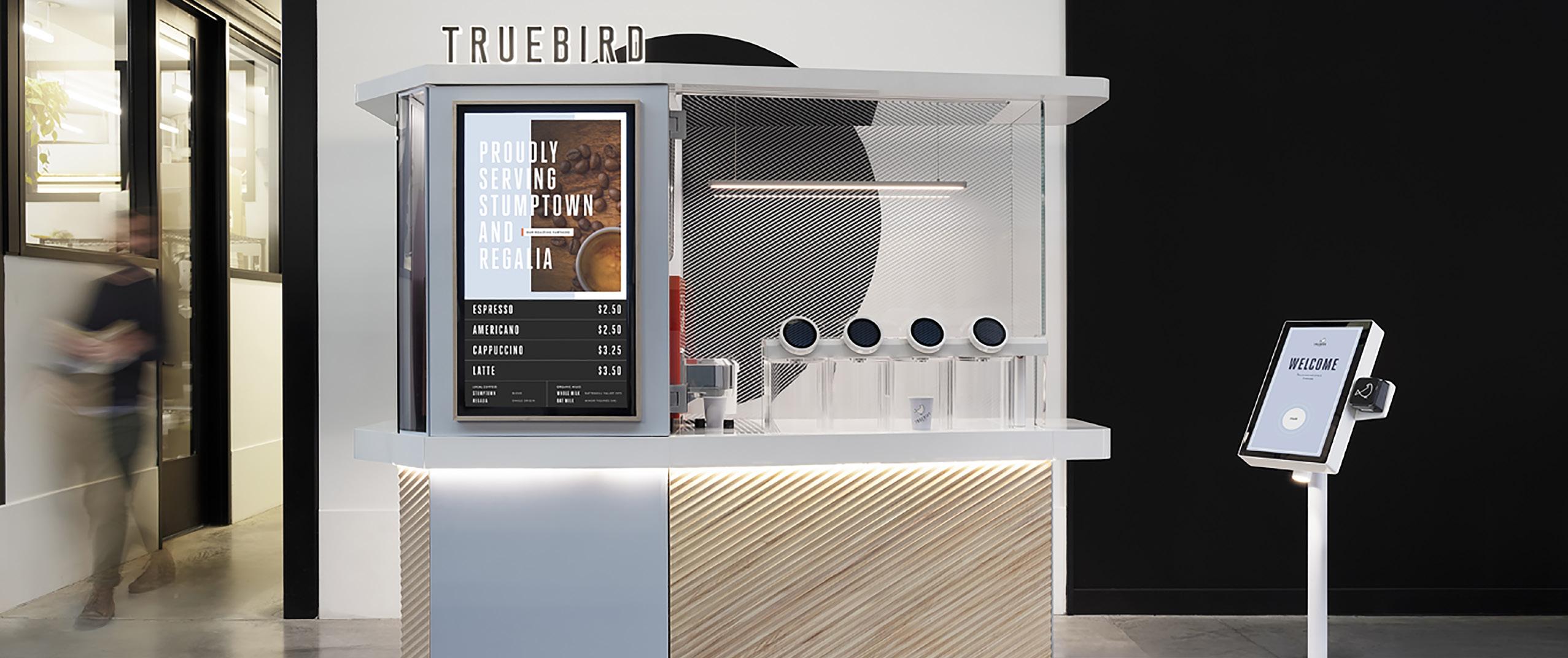
My first job in coffee was as a barista so I have always considered myself a barista first. I loved the process of controlling the grind, dose, tamp, and ROP while frothing perfect silky milk. It was a point of pride, and I transferred that love and self-worth into every cup I served. One day, in 2005 the owners of the café I worked in brought a Marzocco Swift into the shop. This grinder would grind a dose on demand and then tamp it for you (well before the Puqpress). I hated it! Did this grinder think it was better than me? How could a machine take away my power and control over the flavor of that espresso? I felt deflated and like a fraud. How could I look my customers in the eye while the Swift tamped their espresso?
Eventually, I got over it, but I never forgot. Later, working at La Colombe on a pair of vintage FAEMA E61 espresso machines from 1961 I realized my worth again as a Swift would never have worked in that application. Water flowed differently from each of the four groups of the beautiful antique I played like an heirloom cello. I had to tamp at half pressure for the group on the far

2022 | TECHNOLOGY ISSUE COFFEETALK MAGAZINE{ 8 }
JAKE LEONTI | CEO OF F+B THERAPY AND EDITOR-IN-CHIEF, COFFEETALK MAGAZINE
left while for the group on the far right I had to tamp at full pressure. Groups one and two were for espresso as they poured the best and most consistently while groups three and four were for lattes and cappuccinos. This gave me some reassurance though, later work ing in wholesale, I would realize that not everyone paid as close attention to the subtleties of the water flow of each group or the grind setting or consistent tamp pressure. The more removed from the barista role I was and the more baristas I interacted with, the more I noticed the pitfalls and inconsistencies in espresso delivery.
Speaking with Steven Goldman of Truebird Technologies, my sentiment was echoed. “Super-autos, if cleaned and calibrated properly will con sistently make better coffee than a traditional espresso machine.” This is an unfortunate reality if you look at the
full spectrum of coffee service in the world. Not every café is an Onyx Coffee Lab or a La Colombe. The majority are delis, restaurants, ice cream shops, and grocery stores.
Truebird is a technology company based in Brooklyn, New York with a fully automated café experience in a box. The unit integrates AI technology with a customized Eversys super-auto inside. One of the main differences between the Truebird and the Café X robotic arm is that Truebird uses mag nets to move the cup. Rather than the slightly intimidating Terminator arm swinging around to make your coffee you are faced with a Michel Gondry type of whimsical dance of magnets animating your morning coffee.
The Truebird unit is smaller and less dramatic than the Café X robot arm. Each of these new automated coffee
booths still relies on conventional espresso machine manufacturing companies. Eversys has already started working with some of these innovative companies.
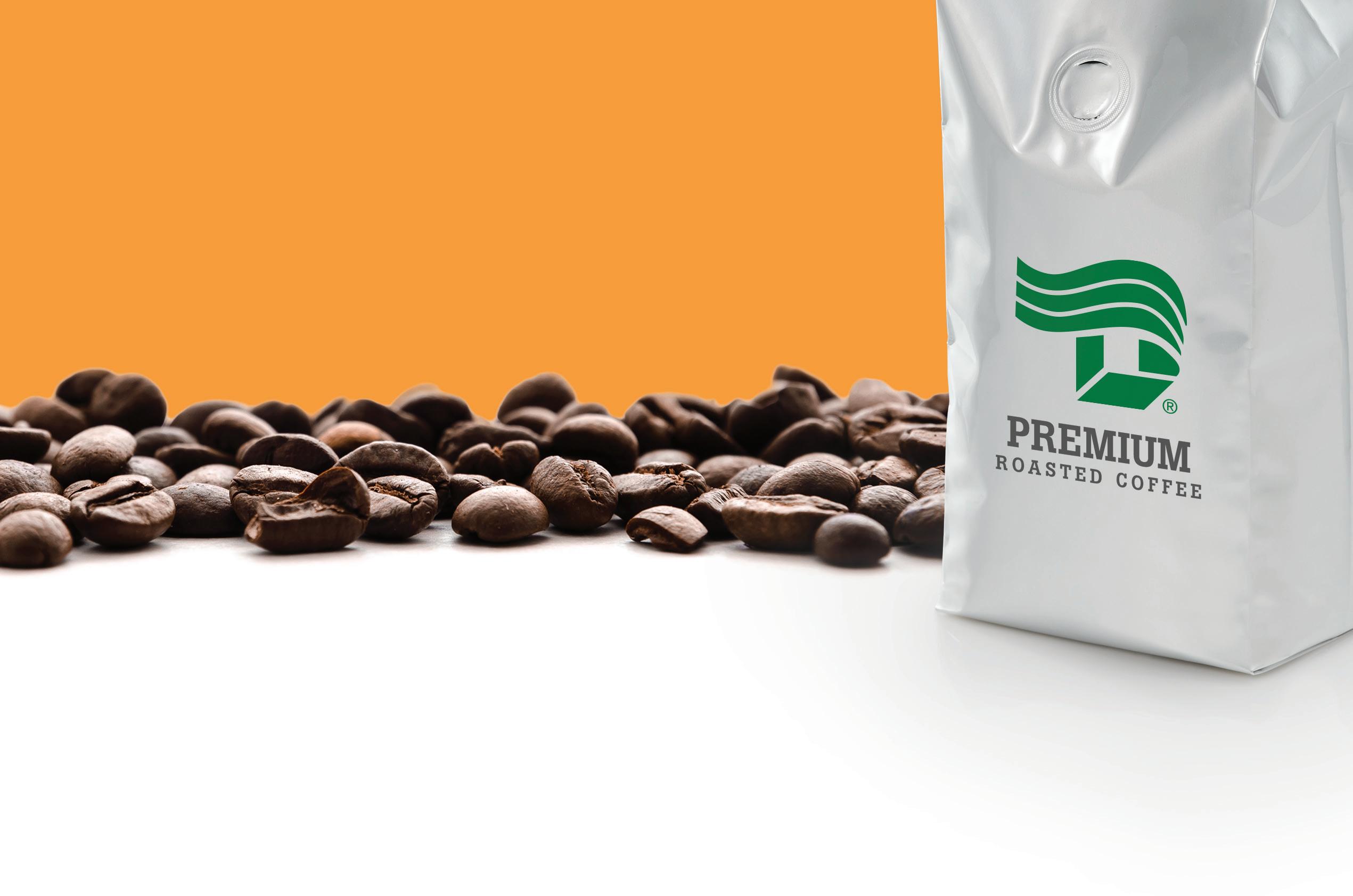
I recall a speech that Heather Perry gave at the New York Coffee Festival in 2018 where she talked about the future of automation in coffee. She described the role of the barista as evolving from a crafts person to more of a knowledgeable customer service coffee expert like a sommelier in wine. So, I thought, why aren’t there sommelier robots? Why are these tech companies picking on baristas? Turns out, there are robot sommeliers on the market already as well. If you’re wealthy, you can even get one for your home. The robotic sommelier can provide pairing suggestions or wine selections based on your flavor preferences. Then it can pull out the climate control stored wine, open the bottle and pour it for you.
We got this one in the bag.
dioxide to escape from a package

Our signature one-way degassing valve
allowing in
providing the optimal air-tight package.
single source,
ISSUE #7 | 2022WWW.COFFEETALK.COM { 9 }
allows carbon
without
oxygen or moisture,
Our
“system approach” to packaging whole bean or ground coffee, includes: Reliable Machines High Performance Materials Degassing Valves Unparalleled Service Technology and Innovation + + + + For more information, contact: Coffee@fresco.com | 215.721.4600 | fresco.com >>
BARISTA3PO
Continued
Demetria is an AI tech company that developed an infrared scanning device that combines AI tech to determine the flavor characteristics of a green or roasted coffee by reading its chemical composition. This could easily be com bined into one of these robotic cafes and do the complete job of the barista.

The only part that would be missing is the human element; this can be good and bad. A robot doesn’t call out sick. A robot doesn’t ask for a raise or need health insurance. A robot doesn’t get tired or emotional. A robot doesn’t share drama or steal from you.
A robot will also never truly recognize you or share its story or joy. A robot will never surprise you with a drink you didn’t order but secretly always wanted to try. A robot cannot pass energy or love to you by making something with the care that was meant just for you.
Mr. Goldman at Truebird makes a point of saying, “there will always be a place for a barista experience in a coffee shop,” as he admits to cherishing his weekend ritual of engaging with a barista while getting a handmade beverage. “It’s just not for every place and time,” he finishes.
The greatest applications of these automated units are in transportation hubs, hospitals, offices, and hotels. Places that are difficult to operate in, don’t justify the labor expense or don’t have space for a full café build.
Some of the greatest benefits are environmental. Brewing and serving everything with calculated precision reduces waste heavily; waste of water, milk, and electricity. Milk waste alone is a huge benefit both environmentally and financially to the shop's owner. The University of Edinburgh estimates that one in six pints of milk produced is thrown away or lost. Coffee shops are great perpetrators of this waste primarily when it comes to using the wrong size pitcher for the drink or
making a pour quality drink that needs to be remade. Not to mention the gal lons and gallons of milk poured down the drain to train our baristas.
These unmanned operations also bring large financial benefits that affect some of the highest-cost line items in any coffee shop budget. The high-cost items include labor, rent, food cost, and energy. Labor is the obvious one. Rent is reduced because the square footage is reduced tremendously with efficient use of space and mechanical integra tion of production. Food cost is reduced with wastage reduced and energy costs go down as all these electronics are customized to run with more efficient energy use.
As a barista, I am a little saddened by the idea that my beloved position could be replaced. As a business owner, I am encouraged to see a solution that can make high-cost and difficult locations a possibility for a profitable business. As an environmentalist, I am excited
by the opportunity to reduce waste yet trepidatious of the cost to our culture. Must we solve all the problems we cre ated during the Industrial Revolution with more industry? Is the coffee itself the important part or is it that human interaction we get in our coffee shops?
I’m sure there is a middle ground here, seeing a robot in a hospital or airport makes sense to me. All things have their appropriate applications.
Let this serve as a call to the baristas of the world to be as human as possible; connect with your customers, smile, and engage. Baristas, taste the espresso when dialing in, and listen for what your customers like. Take the time to make the drink right and be mindful of your waste. Baristas, bring your charm and energy, and stories to the table and start customers' day off right with a good feeling. Being human is the only way to be irreplaceable.
2022 | TECHNOLOGY ISSUE COFFEETALK MAGAZINE{ 10 }
from page 9











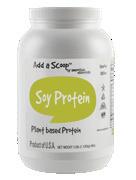

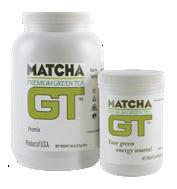



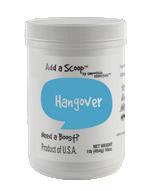






ISSUE #7 | 2022WWW.COFFEETALK.COM { 11 } FOR SAMPLES CALL: 1.877.889.1866 French Creamy Vanilla hot cold Powdered Nutritives for Maximum Health Add a Scoop Blends are a wide range of functional supplements. Almost all Add a Scoop Blends have no color or flavor, making them easy to add to your favorite blended drink. On our website you’ll find detailed information on each blend’s ingredients and benefits, so you can pick the one that’s just right for you. Add a Scoop™ Supplement Boost Call today to learn how Add a Scoop Supplement-Boosts can help you promote wellness and increase profits. 415.382.6535 | www.AddaScoop.com HALAL, KOSHER, VEGETARIAN & GMO FREE Other Available Blends: CALCIUM BLEND, ENERGY BLEND, IMMUNE SUPPORT BLEND, MULTIVITAMIN BLEND, PROBIOTIC BLEND, PROTEIN BLEND, RELAXING BLEND, SMART BLEND, WOMEN’S BLEND
ENSURING SUSTAINABILITY
 { A People-Centered Partnership }
BILL FISHBEIN | EXECUTIVE DIRECTOR, THE COFFEE TRUST
{ A People-Centered Partnership }
BILL FISHBEIN | EXECUTIVE DIRECTOR, THE COFFEE TRUST

{The article in Coffee Talk Magazine, “Ensuring Sustainability,” by Grayson Caldwell, sheds light on one of specialty coffee’s most egregious deficiencies that have been hidden in plain sight for decades: the inexcusable inability of specialty coffee to make a credible effort on behalf of coffee producers - who are the foundation upon which the entire trade is built - to earn a living wage. On a positive note, Grayson points to the digitally oriented, data driven, Verified Living Income (VLI) partnership between Heifer International, Bellwether Coffee, and Sustainable Harvest and the effort to liberate coffee producers from the role of “price takers” in a global trade that sets the price for producers to “take.”

Grayson accurately reports the failure of specialty coffee’s so-called efforts to improve coffee producers’ income, which has been dwindling for more than a generation. The specialty coffee trade has long acknowledged that paltry payments to producers threaten the livelihoods of producers and threaten the sustainability of specialty coffee itself. The hand-wringing that has accompanied the acknowledgment has largely remained the same. It is hardly surprising that simply talking about paying higher prices to produc ers has not resulted in actually paying higher prices to producers. However, the Verified Living Income (VLI) effort is not idle talk. It’s a serious effort to do something about this long-stand ing blight on specialty coffee.
That said, I would encourage VLI to use a less data-driven approach in favor of a more people-driven approach. It never ceases to amaze me how much data drives our efforts at origin. No matter how often we learn how differ ent one producer is from another and no matter how many times we realize that each micro-climate holds within it its own unique characteristics, we still try to establish some common formula to solve one issue for all farmers. No matter how much data we collect, we cannot possibly determine a one-size-fits-all Living Income for all producers. There are a number of reasons for this. Here are two:
1) If we in the north are in any way involved in the data analysis, let alone the results, the entire exercise will be riddled with the conflicts
2022 | TECHNOLOGY ISSUE COFFEETALK MAGAZINE
2) Producers need more income. We know this already without any further data. How much income they need is none of our business - no more than our income is any of their business, although those figures would surely raise a few producers’ eyebrows.
Specialty coffee’s lucrative profits are earned here in the States and in other more economically advanced nations. Paltry producer profits (otherwise known as losses) are earned at origin. We so often refer to producers as our partners. How about a genuine “we’re in this together” partnership?
It doesn’t require the digital world to lift a finger to walk the talk toward a living wage for producers. Consider the following non-datadriven approach toward the same goal. It’s just one of many possible people-driven approaches, and all it requires is getting out of our data-laden mindset and recogniz ing that this issue could have been resolved years ago, long before all this data was accessible anyway.
THE DREAM
(What is the use of a goal if it’s not attached to a dream?):
Specialty coffee wholesalers and retail ers split their gross profits equally with producers, 50-50 like true part ners. Call it something like 50-50 For Farmers. Gross profits on coffee beans and coffee beverages sold would be cal culated with half the gross profits sent back to the producers. Wholesalers and retailers pay their expenses out of their half of the gross profits. Producers pay their expenses out of their half of the gross profits. It’s a partnership. Here’s how to get there.
THE STRATEGY:
It is reasonable to assume that a 50-50 split among all participating produc ers and merchants may not be possible right away. So, merchants would state the 50-50 goal and a timeline
for getting there. Each merchant may state a different formula, such as, say, ten years at 10% per year. From time to time, adjustments may need to be made to the timeline of the 50-50 partnerships. These adjustments would be public, perhaps displayed on a thermometer-like graphic on social media or in stores, clearly articulating each merchant’s path toward their 50-50 For Farmers Goal.
It stands to reason that consumer prices would increase in order to accommodate reasonable profits for producers and merchants. But those prices would increase slowly so as not to overwhelm consumers with a vast increase all at once. Consumer prices would increase incrementally at a rea sonable pace until both producers and merchants could earn a living wage.
Consumers have been keeping pace with specialty coffee’s increased prices for the last 35 years. The specialty coffee trade was founded on higher consumer prices. For over a gen eration, coffee prices have steadily increased due to the increased price of labor, rent, utilities, insurance, trans portation, etc. While consumer coffee prices have risen steadily to cover these additional costs, producer prices have essentially remained the same.
When a serious Fair-Trade cam paign was established, consumers were easily convinced to pay higher prices for Fair-Trade coffee. So, undertake a serious VLI Campaign.
Who better to be a frontline partici pant and leader? The Specialty Coffee Association (SCA)! What a goal for SCA, the global coffee association, to spearhead an international marketing campaign informing consumers that the price of coffee is finally going to rise incrementally so farmers can survive and consumers can continue to enjoy specialty coffee. And who better to convince the SCA that it is in their interest to undertake a serious
campaign towards a real living wage for producers? The original VLI stakeholders themselves - Bellwether Coffee, Heifer International, and Sustainable Harvest. They are already committed to the goal.
The SCA’s international campaign could then complement a Barista Guild Campaign, a focused and concerted campaign like the SCA’s, but with a more intimate, over-thecounter, up-close-and-personal communication, strategically inter acting with consumers face to face.
The message is simple. For gener ations, specialty coffee has never provided producers a living wage. It has now reached a breaking point. If there is not enough income in specialty coffee for producers to raise their families in dignity, there will be no more specialty coffee.
When quality in the cup comes at the expense of quality of life at origin, it makes a mockery of specialty coffee’s long-standing association with the word quality. Specialty Coffee never ceases to celebrate itself with championships, awards, parties, and personalized designs on each and every espresso drink that passes over the counter. But by sweeping a living income for producers under the rug, specialty coffee has been hiding the truth and running cover for large chains and independents that have merely been adding paltry premiums for producers on top of a paltry C-price. I believe that we can all be a part of a meaningful change. I’m hopeful that by incorporating the SCA and Barista Guild with the energy and enthusiasm reflected in the VLI movement, putting a people-cen tered strategy in place to establish a true Living Income for producers is possible. In fact, it’s essential.
And there’s no time to lose.
ISSUE #7 | 2022WWW.COFFEETALK.COM { 13 }
ANNOUNCEMENTS
MAHLKÖNIG LAUNCHES NEW US WEBSHOP
You can now purchase the Mahlkönig X54 Allround Home Grinder and its spare parts direct online within the United States! Also find a curated selection of spare parts, burrs and accessories for Mahlkönig's professional grinder portfolio, as well as branded merchandise.

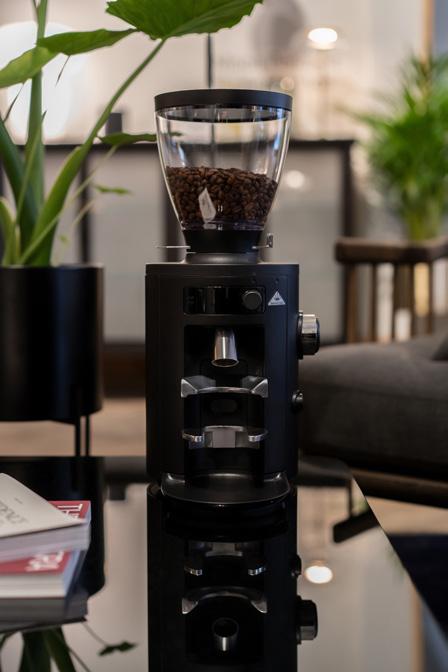
FRANKE INTRODUCES A400 FRESH BREW
The A400 Fresh Brew is the latest innovation in hot coffee from Franke Coffee Systems - Americas. This new system allows for consistent, bean-to-cup, fresh coffee every time. The machine has a small footprint at just under 13.5” wide, that is perfect where counter space is limited. Fully auto matic, the machine walks customers through the ordering process in three quick steps to produce up to four sizes of hot coffee. The 400 Fresh Brew has two bean hoppers with dedicated grinders to ensure consistent, quality flavor.
franke.com
MAHLKÖNIG GRIND-BY-WEIGHT TECHNOLOGY
Mahlkönig is excited and proud of the newest addition to their line-up of next generation espresso grinders - the E80S GbW (Grind-by-Weight). Speed Meets Accuracy with an 18gram output in less than 3 seconds and dosing weight accuracy of up to 0.1 grams (the difference of less than a single coffee bean). E80S GbW will optimize your espresso preparation to ensure the best tasting coffee with each shot and reduce time spent on equipment training for staff. Its heavy-duty motor with two temperature-controlled active fans will keep up in the busiest of cafes, while saving coffee aroma, even during rush-hour.

2022 | TECHNOLOGY ISSUE COFFEETALK MAGAZINE{ 14 }
{ mahlkoenig.us }
{
}
{ mahlkoenig.us } Mahlkönig 47.60383,-122.33006 Mahlkönig 47.60383,-122.33006 Franke 35.98245,-86.51994
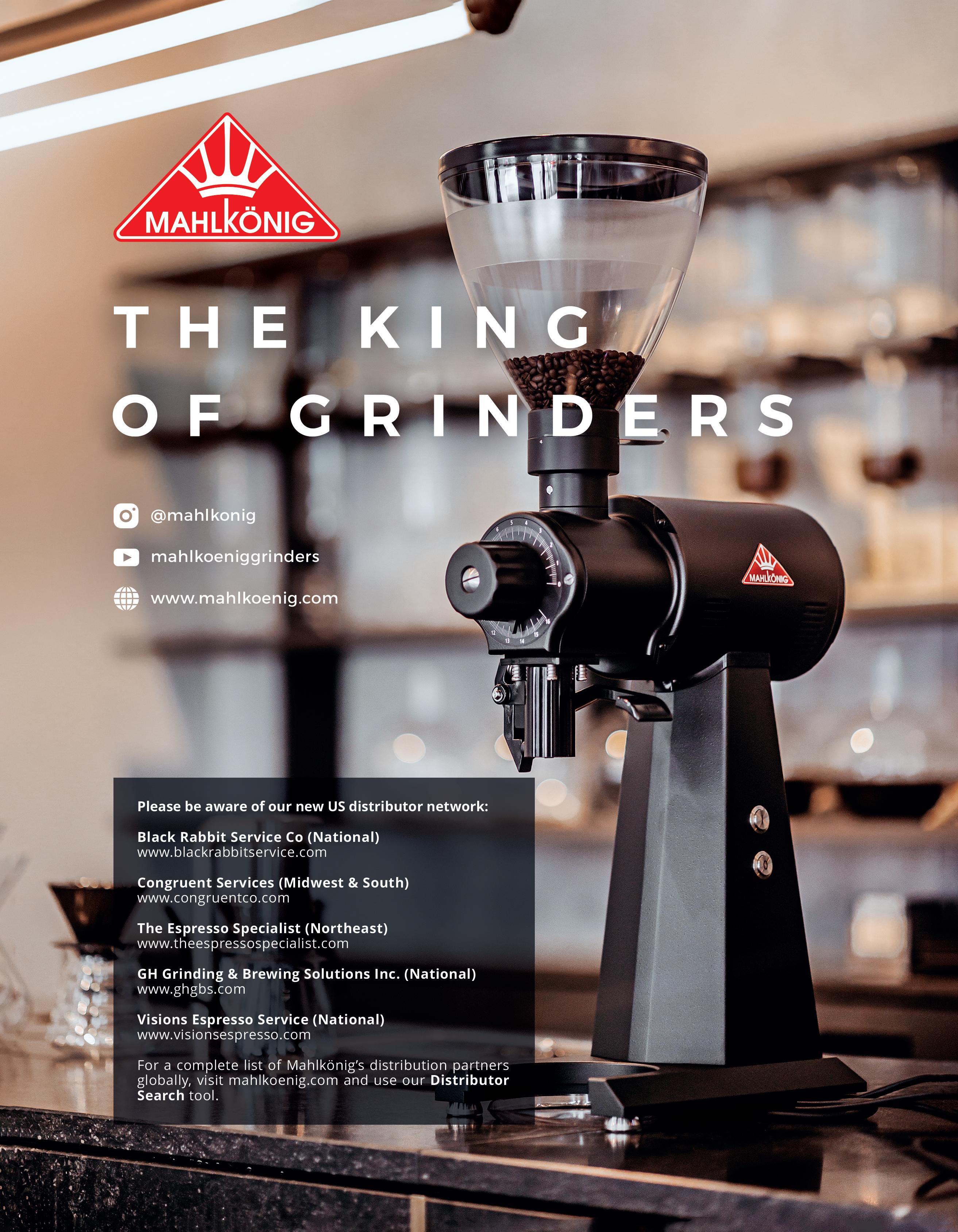








































 { A People-Centered Partnership }
BILL FISHBEIN | EXECUTIVE DIRECTOR, THE COFFEE TRUST
{ A People-Centered Partnership }
BILL FISHBEIN | EXECUTIVE DIRECTOR, THE COFFEE TRUST






